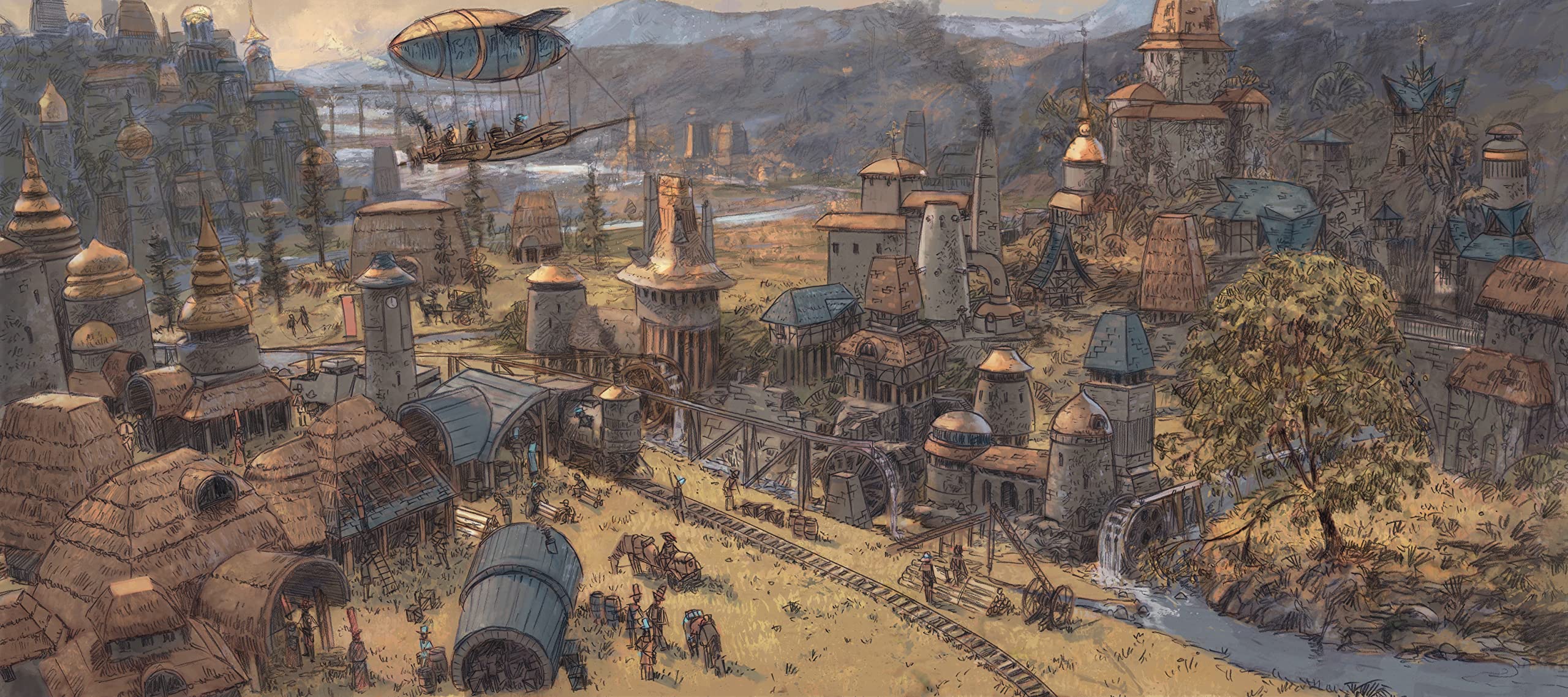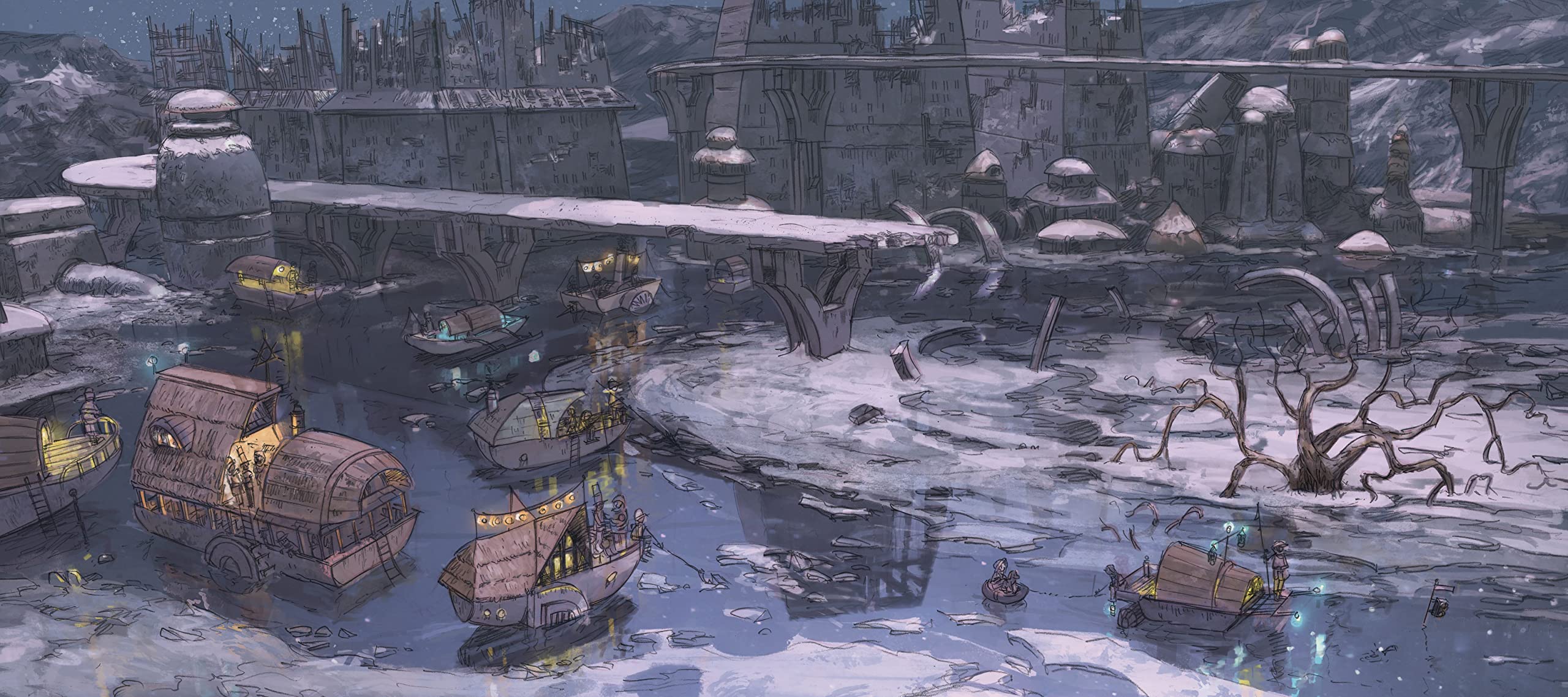Review of the Day: The Tree and the River by Aaron Becker

The Tree and the River
By Aaron Becker
Candlewick Press
$18.99
ISBN: 9781536223293
Ages 3-9
On shelves March 14th
Entropy!
Not a lot of picture books out there on the subject. Not a lot of picture books out there covering the rise and fall of whole civilizations either, but here we are. Or, rather, here Aaron Becker is. In the world of 21st century picture book creators, it can be hard to stand out from the crowd. Never before have more people created more picture books for the American market. The sheer number of them coming out every month just boggles the mind. How do you stand out from the crowd? It’s probably a good idea to have a niche. An area where you excel above and beyond your fellow compatriots. And from the start, Aaron Becker decided that that niche would be to go big or go home. Sweeping vistas. Epic storylines. Quests. Deep dives into ancient history. Proving that picture books are for more than preschoolers, Becker’s challenge his readers. Much like picture books of the past (like those created by Mark Alan Stamaty or, to certain extent, Anno) Becker’s titles invite the readers to take the deepest of deep dives into his books. And while I adore his Journey trilogy, there is still no better example of this than the equally wordless The Tree and the River. It’s going to strike a lot of adult readers as an environmental tale, and that’s a part of it. But on beyond that, the book is a recording of a human history, not unlike our own, where choices, good and bad, lead to irrevocable changes and, ultimately, a bit of hope.
When this book begins, a young tree is growing on a small peninsula at the side of a river. People populate the banks and with every turn of the page more and more time goes by. Their villages grow. Rival villages sprout up. There are hints that battles occur in the space between the page turns, but soon things become industrial. Technology increases as does the sophistication of the wider world. Even so, change will have its way with these people, and by the time the tree drops its final acorn, the old one will have passed away, and new life will be in the making. A smartly drawn, creative take on our cyclical world.
ADVERTISEMENT
ADVERTISEMENT

It shouldn’t have to be notable, but is just the same, that what separates The Tree and the River from a lot of other books for young readers covering broad, sweeping amounts of time is Becker’s disinclination to moralize. American picture books, by their very design, are written to instruct children in how to think, feel, and interpret the world around them. In some alternate universe, a version of The Tree and the River that engages in overt didacticism must exist. Happily this particular book lives by the creed of showing rather than telling. If you want to come to the conclusion that global warming is responsible for the flooding late in this title, you are absolutely able to do so, but Becker’s not going to spell that one out for you. In a way, his ability to step back and let the pictures do the talking, results in a story that is more comforting than one might expect. Yes, civilizations topple over time, but there is life and hope and birth and change. When you get to the end of this book you are free to take the gloomy view that this storyline is cyclical and will happen over and over to the human race, or you can opt for the lighter view that maybe this time they’re gonna get it right.
Now let’s take the fact that the book doesn’t hit you over the head with any clear-cut messaging as one of Becker’s central tenets. He has others, of course. The choice to make his books wordless is tied directly to that avoidance of moral instruction. It is also, in many ways, the key to these images’ success. Without words, children are forced to make sense of the pictures on these pages themselves. One of the great gifts of The Tree and the River, therefore, is this capacity to feed into the brains of children. For example, they might look at that page where the world has been flooded and notice that on some of these boats there are still people wearing those tall top hats made popular by the blue army. But, go a little earlier, and did you notice that in the sequence that takes place during a time period that looks a lot like today, there’s a statue commemorating one of the heroes of the war, and it’s wearing the clothes of the red army. I mean, I haven’t read any interviews with Mr. Becker about the book, but if I were to make an educated guess I’d suspect that he probably also doesn’t necessarily know what went down in this world he created. Imagine tapping into that well of imagination. Where you can literally conjure up worlds so vast that you create them knowing that they will, in turn, lead others to extrapolate far beyond anything you could have dreamed. All the more so if your preferred readership hasn’t even hit puberty yet.

Even as his storytelling grows wider and more vast, the actual human figures in this book are much smaller and sketched out than in Becker’s previous books. I’ve already mentioned the works of Mitsumasa Anno earlier in this review but honestly there is no better, comparable artist. In books like Anno’s Journey the figures were kept small even as the book transported you through fields and towns and even time itself. Another artist Becker reminded me of here is Elisha Cooper. Some of Cooper’s books, like Train create tiny human figures that somehow, through the barest flick of ink here or there, convey humanity’s physical range. Becker’s people, similarly, are simplified but his is a looser style. Facial features are, for the most part, nonexistent (you’re lucky if you get eyes). And yet, I am continually amazed by how people can look at lines that bear even the slightest resemblance to a fellow human being and identify with them. You want to give these tiny people stories. There’s a scene in this book where it’s raining and a single figure in pink is standing by the tree under an umbrella. Are they waiting for someone? Watching? Why are they the only person in pink? Questions without answers.
You know what kills me? Every single time I look through this book, no matter how many times I’ve looked before, I find something new. Look, Becker’s included a kind of lens flare technique on the page where the sun is setting to the left! Look, there’s a rainbow on the page after the baby tree has started to grow! Look, on the page before the flooding has happened, there’s a bit of foreshadowing with the rain! Look (and when I saw this I got ridiculously excited), if you go way way back to the very beginning of the book, you notice that further up the bank is a dead tree that mimics the way that this tree, at the end of the book, looks. Now look beyond that old tree, half hidden in the shadows. What’s that rusting away? Leave it Aaron Becker to hide something on the publication page that, if you spot it, will change your entire perspective of this book.

Becker keeps the book’s focus fairly fixed on a single spit of land. That means that no one person ever takes precedence. There is no stand-in for the child reader, excepting the tree. And without an avatar on the page, the child turns detective, sniffing out clues, making up stories. The kids are now holding up a lens to a civilization that cannot speak to them, but begs to be understood. But that’s Becker for you. He’ll make budding anthropologists and archaeologists out of the lot of them. The Tree and the River. A book unafraid to assume that your kids are smart enough to figure out what it all means.
On shelves March 14th
Source: Galley sent from publisher for review.
Filed under: Best Books, Best Books of 2023, Reviews, Reviews 2023
About Betsy Bird
Betsy Bird is currently the Collection Development Manager of the Evanston Public Library system and a former Materials Specialist for New York Public Library. She has served on Newbery, written for Horn Book, and has done other lovely little things that she'd love to tell you about but that she's sure you'd find more interesting to hear of in person. Her opinions are her own and do not reflect those of EPL, SLJ, or any of the other acronyms you might be able to name. Follow her on Twitter: @fuseeight.
ADVERTISEMENT
ADVERTISEMENT
SLJ Blog Network
One Star Review, Guess Who? (#202)
More Geronimo Stilton Graphic Novels Coming from Papercutz | News
Parsing Religion in Public Schools
Take Five: LGBTQIA+ Middle Grade Novels
ADVERTISEMENT






